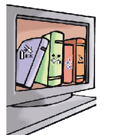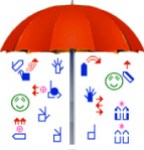 There are more than a hundred sign languages worldwide. Almost half of thesls people who sign can hear perfectly well and for most of them it is a second language. They and the deaf people for whom spoken languages are unheard of share unique cultures and languages.
There are more than a hundred sign languages worldwide. Almost half of thesls people who sign can hear perfectly well and for most of them it is a second language. They and the deaf people for whom spoken languages are unheard of share unique cultures and languages.
All these cultures and languages have the same issues as oral languages; they rely on the passing of knowledge from person to person, from generation to generation. The best way to preserve the language and culture is by making more permanent records, by writing things down by recording video.
I am happy to have interviewed Steve Slevinski; Steve has been responsible for much of the development that brings sign languages to computers and the Internet. One of the ambitions of the SignWriting community is to have their own Wikipedias. Steve is the man who is making this a reality.
Gerard Meijssen
Internationalization / Localization outreach consultant

What is SignWriting?
SignWriting is the international script for writing any sign language. It was invented by Valerie Sutton in 1974. It was written by hand exclusively for 12 years, from 1974-1986. Since 1986, SignWriting continues to be written by hand, but is also written by computer. It has attracted writers from all over the world and continues to reach new audiences.
SignWriting uses a large set of symbols. Each symbol represents a visual conception: either hands, movement, dynamics, timing, head, face, trunk, or limb. The symbols are combined in 2-dimensional visual clusters to create meaningful units.
What is the advantage of writing with SignWriting over writing in English for instance?
With SignWriting you can write visual languages. With English you can write auditory language. To write the English greeting of “hello”, we would use the letters h-e-l-l-o, in that order. To write the American Sign Language (ASL) greeting of hand waving in the air, we would write a hand shape and a movement arrow.
Writing directly in the target language is the goal of SignWriting. A visual language is understood through a visual script. Marks on paper or on a computer screen are transferred into language in the brain.
It is impossible to use English to write a sign language. You can write something that is a translation or a description, but you cannot write the language itself. The closest analogy I can come up with is a circuit diagram. Of course you could describe a circuit diagram with English words, but it would not have the same value or usefulness as a real circuit diagram.
SignWriting is written from top to bottom. What are the advantages?
 Each sign of a sign language is written as a 2-dimensional cluster of symbols. Most commonly, these clusters are arranged vertically from top to bottom.
Each sign of a sign language is written as a 2-dimensional cluster of symbols. Most commonly, these clusters are arranged vertically from top to bottom.
SignWriting is written vertically because Deaf people requested it. Vertical writing is the world standard for writing the native sign languages of the Deaf. SignPuddle defaults to vertical writing out of respect for the Deaf Community. Grammatically it is more correct to write vertically when writing directly in sign languages.
The vertical arrangement quickly delineates the left and right sides of a sign. This obvious identification of left versus right is very important for sign language and allows for easier reading that flows more naturally.
Vertical writing also allows for writing with lanes, an advanced technique needed to write role shifting.
What is SignPuddle?
Years ago, I wanted to include SignWriting images on a web site. I couldn’t find an easy way to do this, so I created my own solution. The software has evolved from screen captures, to dynamic image creation, to reusable sign data. The data started as comma-delimited, migrated to XML, and finalized into character data.
As I worked with the sign data, I had to make many arbitrary choices. As I used the data, I found out the value of those choices. I’ve been able to improve the encoding model for the sign data to simplify the processing while increasing the speed and power of those processes.
SignPuddle started as my proof of concept application. It has grown into an online application for creating sign data for individual signs or entire sign texts. The interface can be localized. It supports tiered security of viewers, writers, and editors.
SignPuddle Online has a growing body of work, including a sign language corpus of dictionaries and literature, with tens of thousands of signs available in over 40 sign languages. Each dictionary is available as a single XML document of a few megabytes.
What is so significant in the latest release of SignPuddle?
SignPuddle 2 is a milestone for two key reasons: stable data and a reusable engine.
At the end of 2011, I had a breakthrough with approximate search routines for SignWriting. This was the final piece of the puzzle of the encoding model. Since that time, I have finalized and fully documented the encoding model with the Modern SignWriting specification. All of the sign data in SignPuddle 2 is available in this final and stable format.
As SignPuddle grew, I had to deal with issues outside of SignWriting. I had to build a content management system to handle the data SignPuddle was creating. On top of this, I had an evolving encoding format that had to maintain operational compatibility with the existing features. I had a spaghetti code problem where the SignWriting processing was mixed in with everything else.
For SignPuddle 2, I built an external SignWriting open source project called the SignWriting Image Server (SWIS). I extracted all of the relevant processing and built a pure SignWriting project that focused on layout and searching. SignPuddle 2 uses SWIS.
The stable data gets us off of the bleeding edge and the reusable engine makes it possible for others to use SignWriting with a minimal amount of work.
My next project will be a major overhaul of the SignWriting editors. SignPuddle 2 currently uses the old editors and SWIS does not include any editing features.
In the latest SignPuddle, you can write from right to left. What is the advantage of this?
Horizontal SignWriting is primarily for writing translations between spoken and signed languages.
When SignWriting is used in schools, in bilingual education, writing horizontally is useful for translating spoken language texts into written sign languages, helping the Deaf student learn both languages. Since western spoken languages are written from left to right, placing the SignWriting text above the written spoken language sentences is a tool for bilingual reading and comparison. Although some grammar details are lost in Horizontal Writing, it offers other benefits as a bridge between languages.
Now with SignPuddle 2, writers can choose vertical and horizontal writing depending on their needs.
Sign languages are not formal or regulated languages. How does that affect the writing in SignWriting?
There is no authority that decides what is a valid sign and what is invalid. Likewise, there is no authority that decides what is a valid writing versus an invalid writing.
While each of the symbols of SignWriting has an international meaning, there is no firm decree on how to position those symbols. There are various standards for good writing, but the ultimate authority is the reader. Can the sign be understood as written? If so, it is good.
Sign languages are open-ended and expressive. SignWriting captures this with writer freedom and choice.
How hard is it for someone who knows a sign language to learn to read and write his language using SignWriting?
It is easy to learn to read SignWriting. A new reader can immediately guess many of the signs. The SignWriting basics can be learned in a few hours.
Learning to write is more complicated. While it is possible to start writing after learning the basics, the best writers develop their own style with a significant amount of time, effort, and reflection.
There are requests for Wikipedias in sign languages, you worked on a SignWriting extension. How does the new SignPuddle affect this project?
The SignWriting MediaWiki Plugin will benefit from both the stable data and the reusable engine.
The stable data from SignPuddle 2, either from SignPuddle Online or from the XML documents, can be copied and pasted into MediaWiki.
The new version of the SignWriting MediaWiki Extension is currently available. The open source project, the SignWriting Image Server (SWIS), has been wrapped into a SignWriting viewer for MediaWiki. I am pursuing to possibility of running this extension on the Wikimedia servers. I look forward to a design and coding review.
What would the benefit be of a Wikipedia in a sign language?
The best way to improve the literacy in a community is to have a lot of people reading and a lot of people writing. It is my hope that a Wikipedia in a sign language would give a community an easy way to share and improve their writing. More people reading. More people writing. Writing that improves and matures over time. It’s a win-win all around.
Thanks for the questions,
-Stephen E Slevinski Jr

Can you help us translate this article?
In order for this article to reach as many people as possible we would like your help. Can you translate this article to get the message out?
Start translation